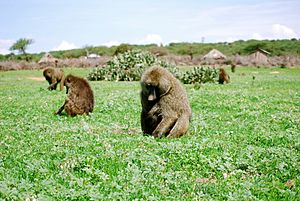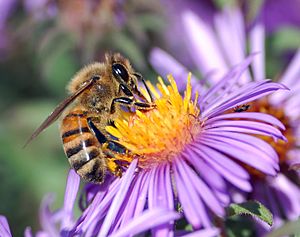Foraging facts for kids
Foraging is when animals search for and gather their food. For example, cattle forage for grass to eat. The idea of animals looking for food in this way is called forage theory. It was first suggested in 1966.
Humans who forage are often called hunter-gatherers. They find and eat wild animals and plants. They do not farm or raise these plants and animals themselves.
Contents
How Animals Find Food

Many things can affect how well an animal finds food. These factors help them get the best food sources.
Learning New Ways to Forage
Learning means changing how you act based on what you have experienced before. Animals live in environments that are always changing. So, being able to change how they look for food is very important for their survival.
Studies of social insects, like ants or bees, show that learning helps them find food better. Young primates, like monkeys, learn how to forage by watching older members of their group. They copy what they see. This helps them learn what is safe to eat and become good at finding food.
One way to measure learning is called 'foraging innovation'. This is when an animal tries a new food or uses a new way to find food. This happens when their environment changes. Foraging innovation shows that animals can change their behavior. They figure out new ways to find food to help them survive.
Animals with larger brains often learn better. Studies have shown that birds with bigger forebrains are better at inventing new ways to find food. For example, some birds learned to follow tractors to eat frogs or insects killed by the machines. Others learned to use swaying trees to catch their prey.
Genetics and Foraging

An animal's genes can also affect how it forages. Scientists have studied this a lot in honey bees. They looked at when bees start foraging, how they share tasks, and if they prefer to collect pollen or nectar.
Honey bees collect pollen or nectar both inside and outside their hive. Studies have found specific genes linked to these behaviors. For example, some genes are linked to the age when a bee starts foraging. Other genes affect how much pollen a worker bee collects. Some genes even influence how much sugar is in the nectar they gather.
Staying Safe While Foraging
Predation is when predators are around while an animal is looking for food. Animals usually balance the risk of being caught by a predator with their need to eat. This means they might change how they forage if predators are nearby. They might not go to the best feeding spots if it's too dangerous.
Images for kids
-
Female lions decide how to hunt and how many lions should hunt together. They also think about protecting their cubs and their territory.
See also
 In Spanish: Forrajeo para niños
In Spanish: Forrajeo para niños




